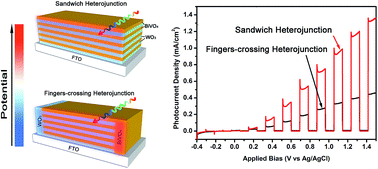Comparison of sandwich and fingers-crossing type WO3/BiVO4 multilayer heterojunctions for photoelectrochemical water oxidation†
Abstract
WO3 and BiVO4 thin films were spin-coated on FTO in a intersecting way with the WO3 and BiVO4 overlapping only in the center part, resulting in multilayer fingers-crossing thin films (fingers-crossing heterojunction). Samples with only an overlapped area (sandwich heterojunction) were obtained by cutting off the non-overlapped area of both the WO3 and BiVO4 layers (the nodes) as a counterpart for comparison. The influence of layer number, layer thickness and junction type on the photoelectrochemical (PEC) water splitting performance under simulated solar light for the obtained heterojunctions was investigated. XRD, SEM, XPS and UV-vis absorption measurements were conducted to investigate the structural properties and morphology. The photocurrent density of the sandwich heterojunction is higher than that of the fingers-crossing heterojunction at a low applied bias. The IPCE shows that both the fingers-crossing heterojunction and sandwich heterojunction can effectively utilize light up to 510 nm. Mott–Schottky plots show that the sandwich heterojunction has a more negative flat band potential, which is desirable for water splitting, than the fingers-crossing heterojunction. In addition, the mechanism of photogenerated carrier separation for these two heterojunctions was discussed.


 Please wait while we load your content...
Please wait while we load your content...